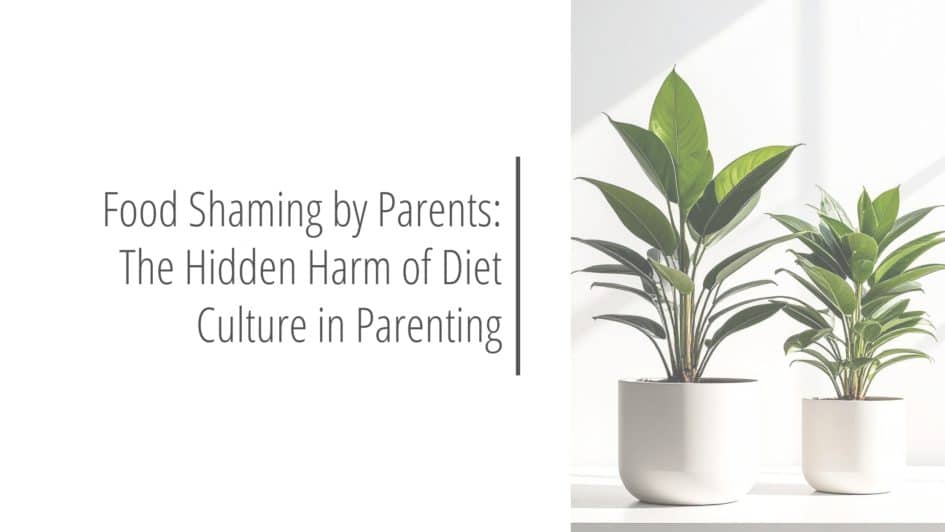Table of Contents
Diet Culture at the Dinner Table
Parenting in today’s world often means navigating a complex maze of advice, trends, and societal pressures. Among the most pervasive influences is diet culture, which is the set of beliefs that equate thinness with health and moral virtue. One of the most subtle yet damaging ways this culture infiltrates family life is through food shaming by parents.
Whether it’s labeling certain foods as “bad,” making comments about a child’s eating habits, or expressing dissatisfaction with their body, these behaviors can have lasting effects on a child’s relationship with food and self-esteem.
What Is Food Shaming by Parents?
Food shaming by parents refers to the act of criticizing, judging, or expressing disapproval of a child’s food choices, eating habits, or body size. While the parent’s intention might be to guide, protect, or promote healthy habits, these behaviors can inadvertently teach children to associate food with guilt, shame, and anxiety.
Food shaming can take many forms, some overt and some subtle:
Verbal Comments
These are explicit statements about what, how much, or how a child is eating. Examples include, but are not limited to:
- “You shouldn’t eat that.”
- “That’s too much for you.”
- “Are you really going to eat all of that?”
Even well-meaning remarks like “Eat your vegetables if you want to grow strong” can create pressure and make children feel judged. Over time, repeated verbal criticism can instill a sense that certain foods, or even the act of eating itself, are wrong.
Non-Verbal Cues
Food shaming doesn’t always require words. Children are extremely sensitive to tone, facial expressions, and body language. Common non-verbal cues include, but are not limited to:
- Eye rolls when a child chooses a “forbidden” food.
- Sighs of exasperation at what or how much a child is eating.
- Disapproving looks when a child reaches for a snack or dessert.
Even subtle non-verbal disapproval can communicate shame and make children second-guess their choices, fostering anxiety around meals.
Comparisons
Parents sometimes compare a child’s eating habits to siblings, peers, or other family members. Examples include, but are not limited to:
- “Your friend eats so much healthier than you.”
- “Why can’t you be more like your sibling?”
- “So and so eats more vegetables than you.”
These comparisons create a sense of inadequacy and competition. Children may internalize the idea that they are “less than” if they don’t conform to certain eating norms, contributing to low self-esteem and negative body image.
Punishments or Restrictions
Food is sometimes used as a tool for discipline or control, which can unintentionally teach children to associate emotions with eating. Examples include, but are not limited to:
- Withholding dessert as punishment for misbehavior.
- Forcing a child to finish everything on their plate regardless of hunger.
- Restricting certain foods entirely as “bad” or “off-limits.”
These practices can lead to unhealthy patterns such as overeating when foods are finally available, sneaking food, or feeling guilty when eating restricted items.
Placing Personal Food Rules on Children
Parents often impose their own food beliefs, diet rules, or weight goals onto their children. Examples include, but are not limited to:
- Sharing details of a personal diet plan and emphasizing calorie counting.
- Discussing personal food restrictions or food rules.
- Critiquing one’s own body or others’ bodies in front of children.
- Taking a child to a weight loss/diet meeting or appointment, such as Weight Watchers
When children observe parents strictly adhering to their own food rules, they may feel pressure to adopt similar behaviors, even if inappropriate for their age. They may learn to judge their own bodies and eating habits harshly.
The Subtle Psychological Impact
While these behaviors might be intended to guide or protect, they often teach children that:
- Some foods are inherently “bad” or “wrong.”
- Eating is something to feel guilty about.
- Their body size or eating choices are a measure of their worth.
Over time, this can lead to chronic worry around food, disordered eating patterns, body dissatisfaction, and anxiety around meals. Even children who appear unaffected may internalize these messages and carry them into adolescence and adulthood.
How Children Absorb Harmful Messages Early
Children are highly impressionable, especially in their formative years. They look to their parents for cues on how to behave, think, and feel. When parents engage in food shaming, children internalize these messages, which can shape their beliefs and behaviors around food and body image.
The Power of Parental Influence
Research indicates that parental comments, both positive and negative, significantly impact children’s perceptions of their bodies and eating habits.
A study found that 61% of adolescents reported hearing negative comments about eating from their mothers, and 44% from their fathers (Loth et al., 2013). These early messages can set the stage for future struggles with food and body image.
Internalizing Shame
Children who experience food shaming may develop a negative relationship with food, viewing it as something to be controlled or feared. This can lead to disordered eating patterns, such as restrictive dieting, binge eating, or emotional eating. Over time, these behaviors can contribute to the development of eating disorders.
And did you know that adolescents are more likely to develop an eating disorder than diabetes (López-Gil et al., 2023)?
The Long-Term Impact on Mental and Physical Health
Food shaming by parents can have profound and lasting effects on a child’s mental and physical health. Early exposure to negative comments about food and body image can lead to disordered eating behaviors, poor body image, and mental health challenges.
Disordered Eating Behaviors
Disordered eating refers to a range of unhealthy eating behaviors that do not meet the criteria for a full-blown eating disorder but still pose significant health risks. A global study found that 22% of children and adolescents exhibit disordered eating behaviors, with girls typically being more affected than boys (López-Gil et al., 2023).
Parental food shaming, such as restricting certain foods or making negative comments about a child’s eating habits, has been linked to an increased risk of disordered eating. Adolescents exposed to higher levels of food restriction by their mothers were more likely to engage in extreme weight control behaviors, such as dieting and unhealthy weight control practices (Loth et al., 2013).
Development of Eating Disorders
Early experiences of food shaming can set the stage for the development of full-blown eating disorders. Girls who were teased about their weight were twice as likely to be overweight, 1.5 times more likely to binge eat, and 1.5 times more likely to use extreme methods of weight control five years later (NEDA, 2023).
The prevalence of eating disorders has been rising globally. Between 2000 and 2018, the prevalence of eating disorders in the general population more than doubled, from 3.4% to 7.8% (Pastore et al., 2023).
Mental Health Challenges
Food shaming can also lead to significant mental health issues. Children who experience negative comments about their eating habits or body image are at a higher risk of developing psychological distress, including symptoms of depression and anxiety (Dahill et al., 2022).
Furthermore, children who experience verbal abuse, such as ridicule or humiliation, have a 64% higher risk of poor mental health in adulthood (Bondy, 2025). This underscores the long-lasting impact of verbal abuse, including food shaming, on mental well-being.
Body Image Issues
Negative comments about food and body image can contribute to poor body image, a significant risk factor for developing eating disorders. A survey found that 77% of children and adolescents as young as 12 dislike their bodies, and 45% say they are regularly bullied about how they look (NEDA, 2023).
By the age of 6 to 10, girls often start to worry about their weight, and by age 14, 60-70% are trying to lose weight (NEDA, 2023).
Breaking the Cycle: How Parents Can Foster a Healthy Relationship with Food
It’s never too late for parents to model positive behaviors and attitudes toward food and body image. Here are practical strategies to help break the cycle of food shaming by parents:
1. Practice Neutral Language Around Food
Describe foods in neutral terms to help children see eating as a natural part of life rather than a moral judgment.
Examples:
- Instead of “Don’t eat that, it’s unhealthy,” try “This snack is sweet and crunchy. How does it taste?”
- Avoid calling foods “junk” or “treats”; instead, say, “This is a food we enjoy sometimes.”
2. Avoid Commenting on Body Size
Focus on abilities and health rather than appearance.
Examples:
- Replace “You look so thin!” with “You’re getting stronger at soccer!”
- Emphasize skill and effort: “You climbed that hill so fast—you’ve got great endurance!”
3. Encourage Intuitive Eating
Allow children to listen to their hunger and fullness cues. Kids are natural intuitive eaters.
Examples:
- Let children serve themselves at mealtimes.
- Ask, “Are you still hungry, or is your tummy full?”
- Respect their choices; avoid forcing them to finish their plate.
4. Model Positive Behaviors
Children learn by observing their parents.
Examples:
- Eat a variety of foods and talk about how it makes you feel, not how it affects your weight.
- Use self-compassion: “I’m having some pasta because it feels satisfying right now.”
5. Create a Positive Mealtime Environment
Make mealtimes enjoyable and stress-free.
Examples:
- Eat together without screens and focus on conversation.
- Avoid turning mealtime into a moral lesson: skip phrases like “If you eat that, you’ll get fat.”
6. Normalize Body Diversity
Expose children to diverse body shapes and sizes to counter societal ideals.
Examples:
- Show media and books with characters of all shapes, sizes, and abilities.
- Celebrate bodies for what they can do, not how they look.
7. Open Communication About Feelings and Food
Encourage children to discuss how they feel about food, bodies, and peer pressures.
Examples:
- Ask, “How do you feel when someone comments on your lunch?”
- Validate feelings: “It makes sense you’d feel upset. You’re not alone.”
Seeking Professional Support
If you notice signs of disordered eating or negative body image in your child, seek professional support. Dietitians, pediatricians, and mental health professionals specializing in eating disorders can provide guidance and resources to help children develop a healthy relationship with food and body.
Final Thoughts
Food shaming by parents, often rooted in diet culture, can have profound and lasting effects on a child’s relationship with food and body image. By becoming aware of the messages they send and making intentional changes in our language and behaviors, parents can help children develop a healthy, balanced approach to eating and body image.
The goal is not a certain body size but a positive and respectful relationship with food and our bodies.
Thanks for reading!
Rachel Beiler, MHS, RD, LDN
References
- Loth, K. A., et al. (2013). Are food restriction and pressure-to-eat parenting practices associated with disordered eating behaviors among adolescents? PMC. Retrieved from https://pmc.ncbi.nlm.nih.gov/articles/PMC3963280/
- López-Gil, J. F., et al. (2023). Global proportion of disordered eating in children and adolescents: A systematic review and meta-analysis. JAMA Pediatrics. Retrieved from https://jamanetwork.com/journals/jamapediatrics/fullarticle/2801664
- National Eating Disorders Association. (2023). Eating Disorder Statistics. Retrieved from https://anad.org/eating-disorder-statistic/
- Pastore, M., et al. (2023). Alarming increase of eating disorders in children and adolescents. The Journal of Pediatrics. Retrieved from https://www.jpeds.com/article/S0022-3476(23)00596-6/fulltext
- Dahill, L. M., et al. (2022). Exploring associations between positive and negative parental comments on weight/shape and eating, with sons’ and daughters’ psychological distress and eating disorder cognitions. Journal of Eating Disorders. Retrieved from https://jeatdisord.biomedcentral.com/articles/10.1186/s40337-022-00561-6
- Bondy, J. (2025, August 5). Verbally abused children more likely to have poor mental health as adults, study finds. The Guardian. Retrieved from https://www.theguardian.com/society/2025/aug/05/verbally-abused-children-more-likely-to-have-poor-mental-health-as-adults-study-finds


Leave a Reply